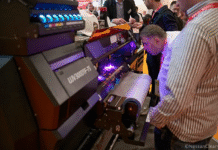
With a rich 75 years in the industry, Efi Reggiani is a printing press manufacturing company that is into rotary, flatbed, and digital printers and the development of inks. The company showcased the Efi Reggiani Terra Silver – a green tech solution with pigment printing in a digital printer at ITME 2022, held at the India Expo Centre in Greater Noida from 8 – 13 December.
“The model offers online curing, which means the polymerization of the pigment is done online in its own dryer. It is not that the customer needs to print and then do curing offline in a loop pager. It’s a sustainable, innovative product. The water required to wash the blanket is minimized to 70 liters per hour instead of 300 liters per hour, which is the case in most textile machines,” says Karthik Ravindranath, regional sales manager at Efi Reggiani.
Another USP is the internal ink recirculation system. “It makes sure the head gets fresh ink, the nozzle plate of the printhead is always wet, there is less downtime, and the life of the head is increased because the temperature is kept in a bandwidth advised by the manufacturer. We have the dryer with internal polymerizers. We have our own software, we have our inks. So it’s a one-window solution completely manufactured by Efi Reggiani,” he adds.
“The Efi Reggiani Terra Silver prints 2,500 meters a day. We are trying to make people understand pigment ink and the process of printing. We are not selling the machine, we are selling the concept. We are getting a very good response at ITME 2022,” says Shashank Saraogi from Fab Nation, Efi Reggiani’s distributor with branches in Surat and Gurugram.
The Terra Silver was launched a few months ago. Within a matter of eight months, it had close to 36 installations worldwide. This was the first time that the machine was exhibited in India. “We are hoping the machine to be the first of its kind, maybe in the north or west India. For our existing models for digital textile printing, we have about 110 units running in the market with customers who have multiple machines instead of just one,” he says.
Efi Reggiani’s customers are spread across the length and breadth of the country with the textile pockets being the major center of installation – Ahmedabad, Surat, Mumbai, and Rajkot in the west; Tirupur and Karur in the south; and Delhi, Ludhiana, and Amritsar in the north. The company has the highest number of installations in the textile pockets of western India. The list of clients includes corporates such as Wellspun, D’decor, DCTEX home furnishing, and other customers such as Sahiba and Akash Dyeing.
Growth of the Indian textile industry
Commenting on the textile industry, Ravindranath said, “The Indian textile printing market is really challenging right now because the reality is pretty brutal – in the sense that the open credit to the market is really long; the bankers are not supporting the industry. They are creating a lot of issues while processing loans. If it used to take 15 days earlier, now it’s taking three months. The local market itself talks about huge capacity. We have a few players who cater to the local market but the quality needs to be enhanced. The market cap size is positive because it’s a value-addition work. I am seeing a 17-20% growth year on year.”
“One thing I see right now is position printing, especially on jacquart or embroidered fabrics. There is a lot of noise for pigment print in terms of green tech and sustainability. I see these two trends kicking off in India right now. I am seeing a few customers looking into nylon fabric with digital printing,” he says on the upcoming trends in textile print.
“I have been in this industry for the last 20 years. I have been a printer myself. In those days, we were sampling 30 meters per day, which was the production too. Now, 30 meters is sampling and production is a minimum of 2-3 lakh meters a month from one exporter. Printers want multiple solutions with one machine – we could print on sequins, embroideries, and textured fabrics. Earlier dark fabric and bright colors were in vogue. Nowadays people prefer subtle, lighter tones,” concludes Saraogi.















